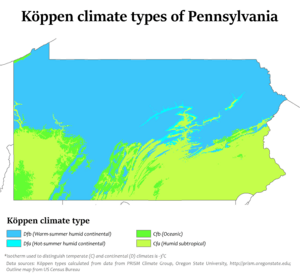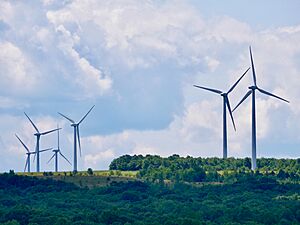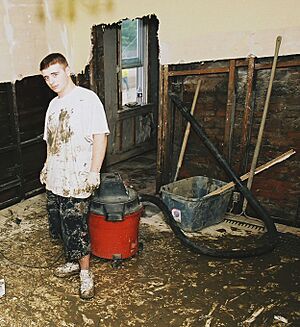Climate change in Pennsylvania facts for kids
Climate change in Pennsylvania means the changes happening in the U.S. state of Pennsylvania because of a warming climate. These changes are mostly caused by human activities, like adding more carbon dioxide to the air.
In 2021, Pennsylvania faced very bad floods from Hurricane Ida. This storm had features that are becoming more common with a warmer climate. These include how strong it got, how quickly it became powerful, and how much rain it dropped over land.
The United States Environmental Protection Agency (EPA) says that Pennsylvania has gotten warmer by more than half a degree Fahrenheit in the last 100 years. Heavy rainstorms are happening more often, and the Delaware River's tidal part is rising about one inch every eight years. In the future, a changing climate will likely cause more floods, harm natural areas, affect farming, and increase some health risks for people.
Contents
Warmer Temperatures and Changing Rain

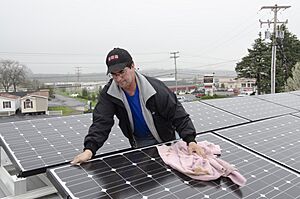
The EPA reports that rising temperatures and different rainfall patterns will likely make both floods and dry spells (droughts) worse. The average yearly rainfall in Pennsylvania has gone up by 5 to 10 percent in the last century. Also, rain from very heavy storms has increased by 70 percent in the Northeast since 1958.
Over the next 100 years, yearly rainfall and the number of heavy downpours will probably keep rising. It's likely to rain more in winter and spring, but not much change is expected in summer and fall. Warmer temperatures will melt snow earlier in spring. This will also cause more water to evaporate, making the soil drier in summer and fall. So, a changing climate will likely cause more floods in winter and spring, and more droughts in summer and fall. In 2011, Hurricane Irene caused the Schuylkill River to overflow. This flooded a train line, bike path, and other important areas in Philadelphia.
Higher Tides Along the Delaware River
The EPA says that the sea level is rising faster along Pennsylvania's coast than in most other places. This is partly because the Delaware Valley area is slowly sinking. If the oceans and air keep getting warmer, the tidal part of the Delaware River could rise one to four feet in the next 100 years. Parts of Philadelphia International Airport and nearby areas are only two or three feet above the average high tide on the Delaware River. In downtown Philadelphia, Penn's Landing and the train tracks at 30th Street Station are currently in an area that floods once every 100 years. Along the Delaware and Schuylkill rivers, higher sea levels could make flooding worse. This could happen during coastal storms or heavy rainstorms, unless communities build things to hold back the rising water.
The freshwater wetlands along the Delaware River might be able to collect enough dirt to keep up with the rising sea level. However, both rising sea levels and more droughts could allow salty ocean water to mix further up the Delaware River. This could kill wetland plants. Where this happens, wetlands might turn into areas with salt-tolerant plants or shallow water. More salt in the water could also cause problems for Philadelphia's drinking water during droughts. This is because salty water might move upstream to the city's water intake at Torresdale.
Inland Waters

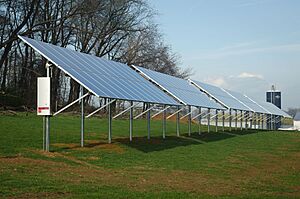
The EPA notes that very high river flows sometimes cause issues for boats on the Ohio and Allegheny rivers. Also, towns along the Susquehanna River and smaller streams sometimes flood. Heavier storms and bigger river flows could make these problems worse. In 2011, heavy rain caused record flooding on the Susquehanna, leading to people being evacuated from Wilkes-Barre. On the other hand, less rain in summer and more evaporation could make some rivers too shallow for boats during dry periods.
Warmer winters mean fewer days when ice stops boats on rivers and the Great Lakes. Between 1994 and 2011, less ice allowed the shipping season on the Great Lakes to be eight days longer. The Great Lakes will likely warm another 3° to 7°F in the next 70 years, which will make the shipping season even longer. But the impact of climate change on water quality is not good. Warmer temperatures often lead to more algal blooms. These can look bad, harm fish, and make water quality worse. Severe storms also wash more pollution from the land into the water, which further increases the risk of algal blooms.
Ecosystems
The EPA reports that a changing climate threatens natural areas by messing up the way different species interact. Wildflowers and long-lasting plants are blooming earlier in spring. Migratory birds are also arriving sooner. However, not all species change at the same speed. This means the food one species needs might not be ready when that species arrives. For example, birds in western Pennsylvania have weighed less during warm years. Warmer temperatures also allow deer populations to grow. This leads to less underbrush in forests, which makes some animals easier targets for predators. Rising temperatures also let new species move into areas that used to be too cold for them.
Agriculture
A changing climate will have both good and bad effects on farming. It's hard to say what the overall effect will be. Longer periods without frost and more carbon dioxide in the air could help many crops grow more in an average year, especially soybeans. But increasingly hot summers are likely to reduce how much corn grows, which is Pennsylvania's most important crop. Spring arriving earlier might also increase the number of major crop pests, like the corn earworm, and aggressive weeds. Higher temperatures make cows eat less and produce less milk. So, a warming climate could reduce the amount of milk and beef produced. Together, these make up more than one-third of Pennsylvania's farm income.


